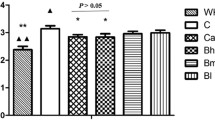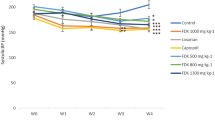Abstract
Antihypertensive treatment is highly important to prevent the progression of chronic kidney disease. Shichimotsukokato (SKT), a traditional Japanese medicine (i.e., Kampo formula), lowered systolic blood pressure (SBP) in experimental animal models of hypertension. However, its mechanism of action has not been fully elucidated. We investigated the potential renoprotective mechanism of SKT in spontaneously hypertensive rats (SHRs). Ten-week-old SHRs were randomly divided into four groups (six rats per group). In the SHR control group, the SBP increased remarkably during the 8-week experimental period. In the SHRs, SKT extract administered orally at a daily dose of 0.45 or 0.15 g/kg significantly suppressed the increase in SBP to the same extent as telmisartan administered orally at a daily dose of 0.01 g/kg. At the end of the experiment, blood, urine, and kidney cortex tissue samples were examined. The SKT treatment significantly decreased urinary albumin excretion to nearly the same level as the telmisartan treatment. A notable loss of chloride channel 5 (ClC-5), a chloride channel in the proximal renal tubules, occurred in the SHR control group. Thus, we concluded that SKT administration significantly ameliorated this decrease. The mechanism of SKT in reducing urinary albumin excretion is mediated, at least partly, by prevention of the loss of ClC-5 in the renal cortex of SHRs.





Similar content being viewed by others
References
Hall ME, do Carmo JM, da Silva AA, Juncos LA, Wang Z, Hall JE (2014) Obesity, hypertension, and chronic kidney disease. Int J Nephrol Renovasc Dis 7:75–88
Ninomiya T, Perkovic V, de Galan BE, Zoungas S, Pillai A, Jardine M, Patel A, Cass A, Neal B, Poulter N, Mogensen CE, Cooper M, Marre M, Williams B, Hamet P, Mancia G, Woodward M, Macmahon S, Chalmers J; ADVANCE Collaborative Group (2009) Albuminuria and kidney function independently predict cardiovascular and renal outcomes in diabetes. J Am Soc Nephrol 20:1813–1821
Gansevoort RT, Matsushita K, van der Velde M, Astor BC, Woodward M, Levey AS, de Jong PE, Coresh J; Chronic Kidney Disease Prognosis Consortium (2011) Lower estimated GFR and higher albuminuria are associated with adverse kidney outcomes. A collaborative meta-analysis of general and high-risk population cohorts. Kidney Int 80:93–104
Lambers Heerspink HJ, Brinkman JW, Bakker SJ, Gansevoort RT, de Zeeuw D (2006) Update on microalbuminuria as a biomarker in renal and cardiovascular disease. Curr Opin Nephrol Hypertens 15:631–636
Deen WM, Lazzara MJ, Myers BD (2001) Structural determinants of glomerular permeability. Am J Physiol Renal Physiol 281:F579–F596
Haraldsson B, Jeansson M (2009) Glomerular filtration barrier. Curr Opin Nephrol Hypertens 18:331–335
Mathieson PW (2004) The cellular basis of albuminuria. Clin Sci (Lond) 107:533–538
Miner JH (2011) Glomerular basement membrane composition and the filtration barrier. Pediatr Nephrol 26:1413–1417
Wickman L, Afshinnia F, Wang SQ, Yang Y, Wang F, Chowdhury M, Graham D, Hawkins J, Nishizono R, Tanzer M, Wiggins J, Escobar GA, Rovin B, Song P, Gipson D, Kershaw D, Wiggins RC (2013) Urine podocyte mRNAs, proteinuria, and progression in human glomerular diseases. J Am Soc Nephrol 24:2081–2095
Patrakka J, Tryggvason K (2007) Nephrin—a unique structural and signaling protein of the kidney filter. Trends Mol Med 13:396–403
Pätäri-Sampo A, Ihalmo P, Holthöfer H (2006) Molecular basis of the glomerular filtration: nephrin and the emerging protein complex at the podocyte slit diaphragm. Ann Med 38:483–492
Roselli S, Gribouval O, Boute N, Sich M, Benessy F, Attié T, Gubler MC, Antignac C (2002) Podocin localizes in the kidney to the slit diaphragm area. Am J Pathol 160:131–139
Gekle M (2005) Renal tubule albumin transport. Annu Rev Physiol 67:573–594
Park CH, Maack T (1984) Albumin absorption and catabolism by isolated perfused proximal convoluted tubules of the rabbit. J Clin Invest 73:767–777
Birn H, Fyfe JC, Jacobsen C, Mounier F, Verroust PJ, Orskov H, Willnow TE, Moestrup SK, Christensen EI (2000) Cubilin is an albumin binding protein important for renal tubular albumin reabsorption. J Clin Invest 105:1353–1361
Christensen EI, Birn H (2001) Megalin and cubilin: synergistic endocytic receptors in renal proximal tubule. Am J Physiol Renal Physiol 280:F562–F573
Devuyst O, Christie PT, Courtoy PJ, Beauwens R, Thakker RV (1999) Intra-renal and subcellular distribution of the human chloride channel, CLC-5, reveals a pathophysiological basis for Dent’s disease. Hum Mol Genet 8:247–257
Piwon N, Günther W, Schwake M, Bösl MR, Jentsch TJ (2000) ClC-5 Cl−-channel disruption impairs endocytosis in a mouse model for Dent’s disease. Nature 408:369–373
Wang SS, Devuyst O, Courtoy PJ, Wang XT, Wang H, Wang Y, Thakker RV, Guggino S, Guggino WB (2000) Mice lacking renal chloride channel, CLC-5, are a model for Dent’s disease, a nephrolithiasis disorder associated with defective receptor-mediated endocytosis. Hum Mol Genet 9:2937–2945
Hiwara N, Uehara Y, Takada S, Kawabata Y, Ohshima N, Nagata T, Ishimitsu T, Gomi T, Goto A, Ikeda T, Yagi S, Omata M (1994) Antihypertensive property and renal protection by shichimotsu-koka-to extract in salt-induced hypertension in Dahl strain rats. Am J Chin Med 22:51–62
Bai F, Makino T, Ono T, Mizukami H (2012) Anti-hypertensive effects of shichimotsukokato in 5/6 nephrectomized Wistar rats mediated by the DDAH–ADMA–NO pathway. J Nat Med 66:583–590
Ono T, Kamikado K, Morimoto T (2013) Protective effects of Shichimotsu-koka-To on irreversible Thy-1 nephritis. Biol Pharm Bull 36:41–47
Nakagami H, Kiomy Osako M, Nakagami F, Shimosato T, Minobe N, Moritani T, Shimamura M, Miyake T, Shimizu H, Takeya Y, Morishita R (2010) Prevention and regression of non-alcoholic steatohepatitis (NASH) in a rat model by metabosartan, telmisartan. Int J Mol Med 26:477–481
Deguchi K, Kurata T, Fukui Y, Liu W, Yun Z, Omote Y, Sato K, Kono S, Hishikawa N, Yamashita T, Abe K (2014) Long-term amelioration of telmisartan on metabolic syndrome-related molecules in stroke-resistant spontaneously hypertensive rat after transient middle cerebral artery occlusion. J Stroke Cerebrovasc Dis 23:2646–2653
The Society of Japanese Pharmacopoeia (2012) The Japanese pharmacopoeia sixteenth edition (JP XVI). Yakuji-Nippo, Tokyo
Kimura M, Shibahara N, Hikiami H, Yoshida T, Jo M, Kaneko M, Nogami T, Fujimoto M, Goto H, Shimada Y (2011) Traditional Japanese formula kigikenchuto accelerates healing of pressure-loading skin ulcer in rats. Evid Based Complement Altern Med 2011:592791
Schneider CA, Rasband WS, Eliceiri KW (2012) NIH Image to ImageJ: 25 years of image analysis. Nat Methods 9:671–675
Nakai Y, Kido T, Hashimoto K, Kase Y, Sakakibara I, Higuchi M, Sasaki H (2003) Effect of the rhizomes of Atractylodes lancea and its constituents on the delay of gastric emptying. J Ethnopharmacol 84:51–55
Yanagi Y, Yasuda M, Hashida K, Kadokura Y, Yamamoto T, Suzaki H (2008) Mechanism of salivary secretion enhancement by Byakkokaninjinto. Biol Pharm Bull 31:431–435
Hultström M (2012) Development of structural kidney damage in spontaneously hypertensive rats. J Hypertens 30:1087–1091
Pavenstädt H, Kriz W, Kretzler M (2003) Cell biology of the glomerular podocyte. Physiol Rev 83:253–307
Huber TB, Benzing T (2005) The slit diaphragm: a signaling platform to regulate podocyte function. Curr Opin Nephrol Hypertens 14:211–216
Chen HM, Liu ZH, Zeng CH, Li SJ, Wang QW, Li LS (2006) Podocyte lesions in patients with obesity-related glomerulopathy. Am J Kidney Dis 48:772–779
Bonnet F, Cooper ME, Kawachi H, Allen TJ, Boner G, Cao Z (2001) Irbesartan normalises the deficiency in glomerular nephrin expression in a model of diabetes and hypertension. Diabetologia 44:874–877
Nakhoul F, Ramadan R, Khankin E, Yaccob A, Kositch Z, Lewin M, Assady S, Abassi Z (2005) Glomerular abundance of nephrin and podocin in experimental nephrotic syndrome: different effects of antiproteinuric therapies. Am J Physiol Renal Physiol 289:F880–F890
Inoue BH, Arruda-Junior DF, Campos LC, Barreto AL, Rodrigues MV, Krieger JE, Girardi AC (2013) Progression of microalbuminuria in SHR is associated with lower expression of critical components of the apical endocytic machinery in the renal proximal tubule. Am J Physiol Renal Physiol 305:F216–F226
Kawachi H, Suzuki K, Miyauchi N, Hashimoto T, Otaki Y, Shimizu F (2009) Slit diaphragm dysfunction in proteinuric states: identification of novel therapeutic targets for nephrotic syndrome. Clin Exp Nephrol 13:275–280
Fogo A, Breyer JA, Smith MC, Cleveland WH, Agodoa L, Kirk KA, Glassock R (1997) Accuracy of the diagnosis of hypertensive nephrosclerosis in African Americans: a report from the African American Study of Kidney Disease (AASK) Trial. AASK Pilot Study Investigators. Kidney Int 51:244–252
Norris K, Bourgoigne J, Gassman J, Hebert L, Middleton J, Phillips RA, Randall O, Rostand S, Sherer S, Toto RD, Wright JT Jr, Wang X, Greene T, Appel LJ, Lewis J; AASK Study Group (2006) Cardiovascular outcomes in the African American Study of Kidney Disease and Hypertension (AASK) Trial. Am J Kidney Dis 48:739–751
Dickson LE, Wagner MC, Sandoval RM, Molitoris BA (2014) The proximal tubule and albuminuria: really! J Am Soc Nephrol 25:443–453
Amsellem S, Gburek J, Hamard G, Nielsen R, Willnow TE, Devuyst O, Nexo E, Verroust PJ, Christensen EI, Kozyraki R (2010) Cubilin is essential for albumin reabsorption in the renal proximal tubule. J Am Soc Nephrol 21:1859–1867
Birn H, Christensen EI, Nielsen S (1993) Kinetics of endocytosis in renal proximal tubule studied with ruthenium red as membrane marker. Am J Physiol 264:F239–F250
Zhou ZY, Tang YP, Xiang J, Wua P, Jin HM, Wang Z, Mori M, Cai DF (2010) Neuroprotective effects of water-soluble Ganoderma lucidum polysaccharides on cerebral ischemic injury in rats. J Ethnopharmacol 131:154–164
Song J, Meng L, Li S, Qu L, Li X (2009) A combination of Chinese herbs, Astragalus membranaceus var. mongholicus and Angelica sinensis, improved renal microvascular insufficiency in 5/6 nephrectomized rats. Vascul Pharmacol 50:185–193
Lee BC, Choi JB, Cho HJ, Kim YS (2009) Rehmannia glutinosa ameliorates the progressive renal failure induced by 5/6 nephrectomy. J Ethnopharmacol 122:131–135
Bai F, Makino T, Kono K, Nagatsu A, Ono T, Mizukami H (2013) Calycosin and formononetin from astragalus root enhance dimethylarginine dimethylaminohydrolase 2 and nitric oxide synthase expressions in Madin Darby Canine Kidney II cells. J Nat Med 67:782–789
Acknowledgments
We are grateful to our colleagues at the Department of Japanese Oriental Medicine and Division of Kampo Diagnostics for the generous support and discussions.
Funding
This study was funded in part by the Uehara Memorial Foundation (Tokyo, Japan).
Author information
Authors and Affiliations
Corresponding author
Ethics declarations
Conflict of interest
The authors declare that they have no conflict of interest.
Rights and permissions
About this article
Cite this article
Ma, Y., Fujimoto, M., Watari, H. et al. The renoprotective effect of shichimotsukokato on hypertension-induced renal dysfunction in spontaneously hypertensive rats. J Nat Med 70, 152–162 (2016). https://doi.org/10.1007/s11418-015-0945-1
Received:
Accepted:
Published:
Issue Date:
DOI: https://doi.org/10.1007/s11418-015-0945-1




